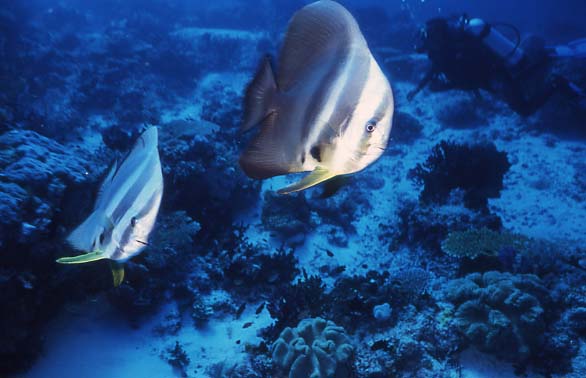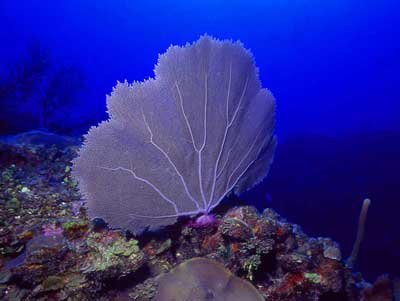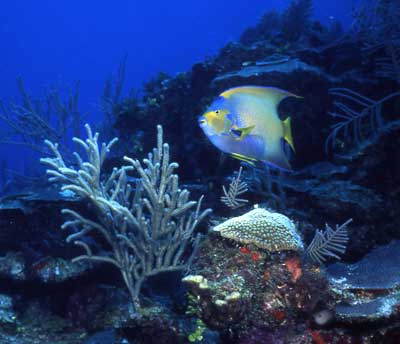
It's hard to imagine now, but back in the day adventure was a primary theme in television shows. For example, every week a show called Sky King showed the adventures of a guy who flew his own airplane around, getting into all kinds of trouble and saving people in trouble. Scuba was a new and adventurous passtime. Mike Nelson, played by Lloyd Bridges, came onto the TV via the classic scuba show Sea Hunt. Jacques-Yves Cousteau had a scuba show in the 1960s that introduced the viewing public to exotic places like Truk Lagoon. When we were kids, we thought that adults had a corner on the adventure market, and we wanted to be a part of that as soon as possible.

Batfish off Kri Island, Raja Empat
I did my first dives off the US west coast. One of the guys who grew up in the neighborhood had a leaky old Chris Craft cabin cruiser, and we pushed off the dock in Hunting Harbor and set a course for Catalina Island. I was going to do my checkout dives for my Open Water certification, so my instructor was aboard. My Brother Matt was with me and my old crony Eric. Larry was at the wheel of his boat and we made the crossing in a couple of hours. The diving off California is characterized by the kelp forests. Kelp is a large seaweed, and the diving is quite dramatic because the stuff is always moving, swaying in the current. Also, diving is a three-dimensional experience, and for the first time I was able to move up and down in the forest. All my life I'd been able to move right, left, backwards and forwards, but having the ability to move in the third dimension, up and down, is a remarkable experience.
I still dive Catalina every now and then, but I've also started going to other places in the world. That's one of the effects that diving has on all of us that call ourselves divers; diving opens new horizons to travel. My brother Matt had always wanted to dive Truk Lagoon, in the central pacific, and in 1998 we scored a major package deal-Airfare and hotel for about $1,000. To put this in perspective, airfare alone is typically about $2,000, so it was a deal we couldn't pass up. We ended up staying at the Truk Stop hotel on the main island of Weno/Moen and dove with an outfit called Micronesia Aquatics. The Truk Stop was owned by an American guy named Bill Stinett, who had been a cop in the USA. Micronesia Aquatics was owned by Clark Grahm, who was one of the first Peace Corps volunteers to come to Truk in the 1960s. These families are old timers who have had a positive influence on the history and development of Truk as it evolves into Chuuk, a state in the new, independent nation called the Federated States of Micronesia. We're fortunate to know them.

Sea Fan on the Barrier Reef, Belize
West Pacific
The Hawaiian Islands have some diving, although I haven't had more than a few dives there. I've also spent some time diving off the coast of Guam. I did a dive expedition to Kri Island, in the Raja Empat district of Irian Jaya, Indonesia. On the way I dove off the coast of Bali. The diving in the Raja Empat is excellent, and the diving elsewhere in Indonesia is also quite good. The water is warm, mixing the Indian Ocean currents with the Pacific and resulting in some of the most prolific biodiversity anywhere on earth. I dove with Aqua Marine Diving in Sanur, Bali and Irian Diving in Sorong, West Papua.
Caribbean
Eventually, most divers spend some time in the Caribbean. I haven't gone to as many dive locations in the Caribbean as I'd like, but I've been diving off the Island of Cozumel and also off the coast of Belize. These are two similar, related places that have important differences. Both places are part of the origin of the Gulf Stream in the western Caribbean, but the diving off Belize is characterized by calm water and the barrier reef, while the patch reefs off Cozumel are swept by fairly strong currents. Cozumel lies between the Yucatan and Cuba, and the flow of the Caribbean gets squeezed through the Yucatan Strait, which strengthens the northbound current. The diving is primarily drift diving. The reefs are well nourished by the passing water, and quite healthy.

Queen Angel on the Barrier Reef, BelizeBelize has a well developed barrier reef, although not as extensive as Australia's Great Barrier Reef. The largest reef system in the hemisphere, it runs north and south. There are many canyons in the reef that start in the shallows and run to the east into deep water. The canyons give the diving an interesting topography, and divers can swim along in the canyons or cross them at an angle, moving into deep water to look for big fish such as Whale Sharks or Eagle Rays, then heading west toward the backbone of the reef, into the shallows at the end of the dive. The diving is easy and lots f fun.
Florida
The diving off West Palm Beach is some of the best in the Continental US. This is where the Gulf Stream departs on its journey across the Atlantic, and the flow feeds a nice reef system that's easily accessible from shore. Since it's in the USA, airfare is reasonable, hotels and rental cars are inexpensive and all the other logistics are straight forward. There are big scuba shops with excellent prices and selection, for example, and finding photography supplies or a good restaurant is as convenient. I dive with Captain Leo at Dive Charters International. I've also dived the Florida Keys, including some of the shipwrecks there.
Bali Page 1 Bali Page 2
South Pacific Home
Sabbatical Home
Click here to e-mail me.